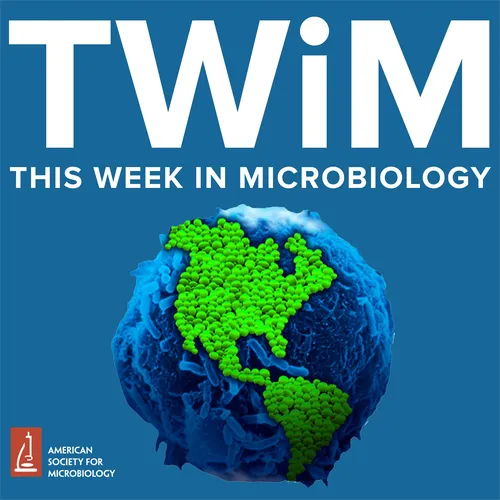
This Week in Microbiology
This Week in Microbiology is a podcast about unseen life on Earth hosted by Vincent Racaniello and friends. Following in the path of his successful shows 'This Week in Virology' (TWiV) and 'This Week in Parasitism' (TWiP), Racaniello and guests produce an informal yet informative conversation about microbes which is accessible to everyone, no matter what their science background.
- Update frequency
- every 15 days
- Average duration
- 63 minutes
- Episodes
- 341
- Years Active
- 2011 - 2025

340: Microbes in Trees and Plants
TWiM explores the varied and distinct microbiome of trees, and an array of biopesticidal metabolites against mosquito larvae isolated from a Mediterranean island.
Become a patron of TWiM.
L…

339: Missing the Company of Elio
TWiM pays tribute to Elio Schaechter, former TWiM host, blogger, and microbiologist extraordinaire, then reviews the finding that Archaea produce peptidoglycan hydrolases that kill bacteria - a form …

338: Rewriting the Code of Life
TWiM discusses outbreak of Legionnaires disease in Harlem NY, an automated whole genome sequencing platform for bacterial strain typing in clinical microbiology laboratories, building E. coli with a …

337: Lifestyles of the Plasmids
TWiM explains a study that examines pathogen presence in ancient humans and concludes that zoonoses emerged 6500 years ago with the domestication of livestock, and determination of universal rules …

336: The Volatilome of Biofluids
TWiM explores the use of gas sensors and machine learning to identify microbes and antimicrobial resistance in clinical specimens, and how a harmful algal bloom species releases thiamin antivitamin…

335: Slip Slidin’ Away
TWiM explains two strategies for bacterial competition for resources: by laying down a slippery lipid and pushing away competitors, or by breaking open cells with a spike, liberating essential nutrie…

334: Fungal Smuggle
TWiM describes how microbiological analysis of the Gowanus Canal in Brooklyn has revealed an antimicrobial resistance reservoir and bioremediation potential, and fungicide resistance in Fusarium gram…

333: When Mutualists Murder
TWiM explains how a mutualistic model bacterium can become lethal in a non-symbiotic host, and engineering a kill switch into a tuberculosis vaccine for improved safety.
Hosts: Vincent Racaniello, Mi…

332: Fibromyalgia Pain and the Gut Microbiome
TWiM explains a study of the unique and extreme microbial and chemical environment on the International Space Station, and the connection between the gut microbiome and pain in fibromyalgia.
Hosts: V…

331: Radar Love in Bacteria
TWiM describes isolation of a novel bacterial species isolated from the China Space Station, and how a chemical radar allows bacteria to detect and kill predators.
Hosts: Vincent Racaniello, Michael …

330: More mouth Microbiology
TWiM explains how to recode E. coli so it uses only one stop codon, and an exploration of the mechanisms of bacterial adhesion within dental plaque.
Hosts: Vincent Racaniello, Michael Schmidt, Petra…

329: Bacteria Hunt With Grappling Hooks
TWiM explains Pasteur’s relentless hunt for microbes in the air, and how bacteria hunt for prey by ixotrophy - using grappling hooks!
Hosts: Vincent Racaniello, Michael Schmidt, Petra Levin and Miche…

328: Capturing Shigella With Filopodia
TWiM describes Shigella infection is facilitated by interaction of human enteric α-defensin 5 with a colonic epithelial receptor, and an amino acid change in RNA polymerase that leads to resistance t…

327: Freezing and Anti-Freezing With Bacteria
TWiM explains the remarkable abilities of bacterial ice nucleating proteins to promote freezing of water, and cryoprotective proteins produced by worm microbiomes that prevent freezing.
Hosts: Vincen…

326: I Have One Word For You: PETase!
TWiM explores the discovery of microbial enzymes, PETases, that can degrade ubiquitous plastics, and how exogenous peptidoglycan is a danger signal to trigger biofilm formation.
Hosts: Vincent Racani…

325: Microbes Making Methane
TWiM reveals that record high atmospheric methane growth has been driven by microbes, and the cecum as an adaptive niche for Salmonella typhi.
Hosts: Michael Schmidt, Petra Levin and Michele Swanson.
…
324: Back To School for TWiM
From ASMCUE 2024, the conference on undergraduate education, TWiM speaks with Becky, Melanie, and Katriana about their careers and how they use TWiM in undergraduate microbiology education.
Hosts: Mi…

323: Better Concrete With Microbes
TWiM describes how to make concrete more ‘green’ by using microbes, and bacterial bioluminescence as an important regulator of multitrophic interactions in the soil.
Hosts: Vincent Racaniello, Michae…

322: Photohydrolysis Decontamination Reduces Healthcare-associated Infections
TWiM explains how ticagrelor alters the membrane of S. aureus and enhances the activity of vancomycin and daptomycin without eliciting cross-resistance, and the development of a novel continuous disi…

321: The Microbes in Your Food
TWiM focuses on recent foodborne outbreaks of bacterial infections, and how nanopore sequencing technology can be used to identify pathogenic microbes and antimicrobial resistance genes in food produ…